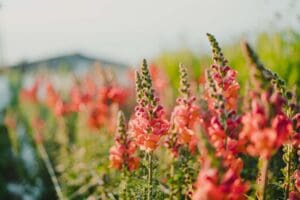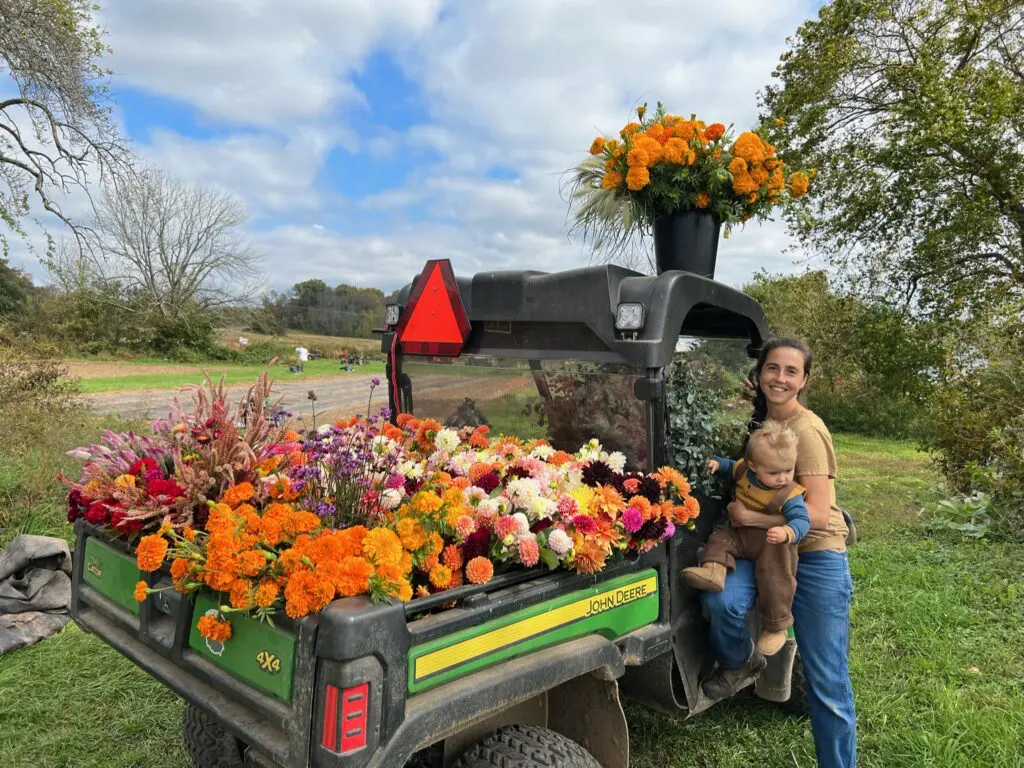Sourcing more sustainable flowers
Fresh flowers help us mark life’s most meaningful occasions, from weddings and funerals to annual holidays to dinner parties with friends. Colorful, aromatic arrangements can breathe life into a space, hold significant meanings for the recipients and make celebrations and gatherings feel extra special.
Those beautiful bouquets, however, can bring troubling climate and humanitarian impacts. The global cut flower industry is fraught with many of the same environmental and ethical issues that can accompany fruit and vegetable production, including worker exploitation, the unregulated use of pesticides and other harsh chemicals and carbon emissions from shipping and refrigeration. In 2022, the U.S. imported nearly $2 billion worth of cut flowers, according to the Department of Agriculture, from places like Colombia, Ecuador, Canada and the European Union — mostly standard-issue stems like roses, carnations and chrysanthemums.
“In flower shops, you see about the same dozen varieties of flowers. They’re basically selected for the ability to ship out of water and last a long time,” says Kristen Jas Vietty, farmer and owner of Lunaria Gardens, a micro-farm and floral design business in Philadelphia. “It’s kind of like in the food industry. Shipment is king, so you have a lot less variety.”
There are also issues around dangerous practices in countries where flower production for export has become a significant economic driver. Investigations in Kenya have exposed exploitative practices for workers, many of them women, including long hours, low pay, sexual harassment and forced labor. In flower powerhouse Ecuador, growers often bring on child labor to meet demand for holidays like Valentine’s Day, and workers face harassment, abuse and health problems due to pesticide exposure.
The unregulated use of pesticides during production, as well as preservatives used to extend vase life, puts those who harvest and handle large volumes of cut flowers at risk. Many countries don’t regulate the use of pesticides on imported flowers, and studies have found that floriculture workers who regularly handle conventionally produced material are exposed to higher-than-average levels of potentially harmful pesticides that could have serious health effects. And these kinds of chemical inputs are also harmful to the environment, polluting soils and waterways and threatening farm biodiversity, including pollinator populations.
But you don’t have to give up your Valentine’s Day bunches, spring tulips or just-because bouquets to avoid these impacts — just source them more thoughtfully.
“The farmer who’s near you is most likely not using hormones and growth regulators and pesticides and preservatives” the way industrial growers are, says Helen Skiba, owner of Artemis Flower Farm outside Boulder, Colorado, and a board member of the Association of Specialty Cut Flower Growers (ASCFG). “That’s the flower you want to put your face in.”
According to 2022 USDA data, sales of domestic floriculture crops totaled nearly $6.7 billion, an increase of 4 percent from the previous year and a nearly 50 percent jump over 2019 numbers. While there are large-scale, conventional flower farms and greenhouses, especially in states like California and Florida that allow for year-round production, small-scale flower production serving local and regional markets is booming across the country. The posies they’re selling are fresher, more sustainable and more varied than your average supermarket bunch.

Skiba attributes this trend to more accessible educational resources for would-be growers, the rise of remote work giving people more time to pursue passion projects like gardening and a desire for nontraditional careers, especially at the onset of the COVID-19 pandemic. “I’ve seen people turning away from some traditional job, especially women who are done with their careers, and they’re looking for something that feels a lot more fulfilling to them,” Skiba says. “It’s a much more approachable idea for people than it once was.” The ASCFG supports education, research and community in the nation’s specialty cut flower industry — “specialty” referring to varieties other than the roses, carnations and ’mums that have been bred to travel thousands of miles to the vase on your dining table. Membership in the organization has sextupled to 3,000 across the U.S., U.K. and Europe in the last decade.
Getting into flower farming can have fewer hurdles and higher rewards for beginning farmers than raising vegetables or livestock does. A fledgling flower operation can begin in a backyard or vacant lot. With an ornamental (rather than edible) crop, regulations can be easier to navigate, and it’s possible to make use of spaces in urban areas where the soil is not suitable for growing food due to contaminants like lead. But one of the biggest draws of flower farming is what customers are willing to pay.
“From a space and economic standpoint, flowers are perhaps the most high-value crops you can grow, not only per acre, but per square foot,” says Vietty. “Flowers are such a perishable, high-value product, especially in the wedding industry, where the needs are so specific that people will pay a premium for them.”
In addition to foraging greens and branches from nearby urban farms and nature centers, Vietty rents growing space on a vacant lot turned beer garden in West Philadelphia. There, they cultivate seasonal specialty blooms for private clients, floral designers and the local co-op grocer from spring through fall. “People are often surprised when they see that I’m using every inch of space, but it’s still not a ton of space,” they say. Though there are challenges to growing in a shared space in the city, being so close to their customers is worth it, especially when many growers have to travel several hours round trip to sell their products.
On rural farms, cut flowers can help diversify crops and revenue streams for small-scale farm operations, too. About an hour northwest of Philadelphia, Clara Osborne and Jeremy Dunphy run Pasture Song Farm, a 90-acre livestock and cut flower operation. The couple started out raising pastured meats, but Osborne decided to take advantage of their location on a busy roadway and create another source of income with an eye-catching, high-value crop like flowers.

“I would feel kind of vulnerable if we had just one enterprise we were relying on, with how things are constantly changing,” Osborne says. When the pandemic hit, meat sales increased, but Osborne was concerned that nonessentials like bouquets would drop off. Instead, demand grew when consumers were stuck at home and supply chain disruptions made imported flowers difficult for florists to get. “They started sourcing locally, and then I think it just kind of stuck. They realized how much better quality and fresher the flowers were.”
Incorporating cut flowers into vegetable or other diversified farming operations can provide environmental as well as financial benefits. Skiba’s flower business, which is growing on just under 2 acres this season, shares a farm property with a small vegetable CSA. The farmers coordinate crop rotation to maximize yields and soil health, break up disease and pest cycles and attract beneficial insects.
“There are really good synergies that happen between the vegetables and the flowers,” Skiba says. “The diversity of flowers brings in a big diversity of pollinators. The beekeeper who has bees on our farm says his hives have way more pollen than any of the other hives that aren’t on a flower farm. And because we’re growing so many different things, we have fewer problems with persistent pests and diseases because we’re constantly rotating plant families and crops throughout our fields.”
Despite these benefits, small, domestic flower growers still have to compete on price with large-scale imports, and without education, consumers may not see the value behind the higher price tag of Osborne’s short-lived dahlias versus the imported chrysanthemums near the supermarket checkout. Another challenge is that in regions with cold winters, certain flowers — or sometimes any flowers — from local growers may be unavailable for weeks or months, though many use methods like high tunnels and heated greenhouses to extend the growing season.
But Vietty, Skiba and Osborne have seen that once customers experience fresh, seasonal, local flowers, the benefits over the standard imported bouquet couldn’t be more apparent.
“The quality of locally grown flowers surpasses the imported flowers you can buy,” says Osborne. “They’re just more alive. It’s a pretty stark difference. And if you keep buying from that flower farm throughout the season, things are constantly changing. You’re getting different flowers and a different seasonal color palette.”
Skiba agrees. “Grocery store bouquets tend to be pretty uniform. As small flower farms, we have more room to experiment with different kinds of cultivars and offer a wider range of things. You get different kinds of beauty at different times of year.” She recommends reaching out to florists in your area for recommendations for local growers, checking out farmers’ markets and keeping an eye out for roadside stands selling their own blooms. People can also find growers in their area at localflowers.org, a site maintained by the ASCFG.
Vietty notes that sourcing local, seasonal flowers for special occasions can make an impact that lasts long after those blooms have faded. “They’re reflective of the season and the place you’re in. It can help paint the story of your wedding or your special moment that you’re marking in time and space,” they say. “When you see those photos, you know it was a spring wedding or an October wedding with fall foliage. It can better represent culture and memory and place.”
Get the latest food news, from FoodPrint.
By subscribing to communications from FoodPrint, you are agreeing to receive emails from us. We promise not to email you too often or sell your information.
Top photo: Artemis Flower Farm’s Helen Skiba at work in the hoop house. Photo by Nelson Esseveld.
More Reading
Can scorecards push supermarkets to do better?
December 9, 2024
Manure digesters aren’t clean energy
November 6, 2024
Julie Guthman explains why Silicon Valley will not hack the future of food
November 4, 2024
Everyone's talking about ultraprocessed foods — but what exactly are they?
June 27, 2024
Switching from beef to chicken isn't the sustainability flex you think it is
June 12, 2024
Are natural flavors better than artificial?
May 7, 2024
Is a sweeter story possible for chocolate and vanilla?
April 30, 2024
The ins and outs of vegan hot dogs
April 16, 2024
Jamie Loftus and ‘the naked truth about hot dogs’
April 16, 2024
Nearly a year after USDA approval, lab meat is still off the menu
April 10, 2024
